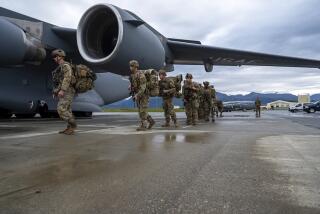U.S., Commonwealth Subs Collide Off Russia : Military: No one is injured. Pentagon denies charges it encroached on territorial waters in last week’s incident.
- Share via
WASHINGTON — In the first publicly acknowledged incident of its kind since the breakup of the Soviet Union, two attack submarines--one American, the other from the Commonwealth of Independent States--collided last week in the icy waters off the Russian naval port of Murmansk, Pentagon officials said Tuesday.
The incident prompted Russian charges that the American vessel, apparently on a spying mission, illegally encroached on Russian territorial waters. The United States has denied the charge, contending the submarine was outside the 12-mile limit.
Bypassing a series of Cold War reporting agreements on incidents at sea, Secretary of States James A. Baker III on Monday discussed the collision directly with Russian President Boris N. Yeltsin.
Officials said the Feb. 11 collision occurred while the U.S. nuclear-powered attack submarine Baton Rouge was traveling at periscope depth just below the waterline. It was struck from below when the Russian vessel began to surface. The Commonwealth submarine was slightly damaged. The U.S. Navy said the Baton Rouge, with 127 aboard, was unharmed and was returning without assistance Tuesday to its home port of Norfolk, Va. There were no reports of injury aboard either submarine.
Defense officials said that at periscope depth, U.S. submarines update their navigational positions, listen for message traffic and eavesdrop on a variety of communications inside and between other countries.
A knowledgeable official confirmed that the U.S. submarine, which was operating near the entrance to Kola Bay, was gathering intelligence on Russian naval fleet activity.
The intelligence gathering was defended by Defense Secretary Dick Cheney. “It’s an important part of our security, and I don’t have any reason to believe there’s any fundamental problem here that requires any change in our policies,” he told reporters Tuesday.
The intelligence mission by the Baton Rouge comes at an extraordinary time for the former Soviet navy. The Russian surface fleet has virtually ceased operations for lack of fuel. But intelligence officials said that the former Soviet submarine fleet--now operated under the Commonwealth because it carries and protects the former Soviet Union’s nuclear weapons--continues to patrol the protected waters off Russian shores.
In those waters, such as the Barents Sea where last week’s incident took place, American and Commonwealth submarines continue to play the dangerous cat-and-mouse game that inspired such Cold War techno-thrillers as Tom Clancy’s “The Hunt For Red October.”
“The U.S. subs continue to operate, and the former Soviet subs are still operating, although not at the Soviet levels,” said Norman Polmar, naval analyst and author. “That puts our subs and theirs in the same waters. So, periodically, you’re going to have collisions.”
While the incidents-at-sea agreement establishes military channels for the transmission of such information, the United States bypassed the accord so Baker could relay news of the collision directly to Yeltsin. Russia responded with allegations that the American submarine intruded upon the territorial waters of the new state, a charge Washington rejected.
One knowledgeable Navy official said it is not uncommon for the United States and other countries to interpret international boundaries differently. The U.S. Navy “gets a pencil and a little mark and measures out 12 miles tracing the coastline, so the 12-mile limit will mirror the shape of the coastline,” the official said.
That approach often draws protests from countries whose coastlines contain wide inlets.
More to Read
Sign up for Essential California
The most important California stories and recommendations in your inbox every morning.
You may occasionally receive promotional content from the Los Angeles Times.













